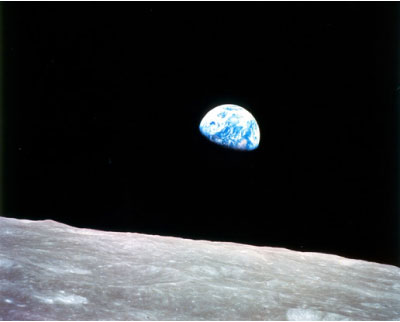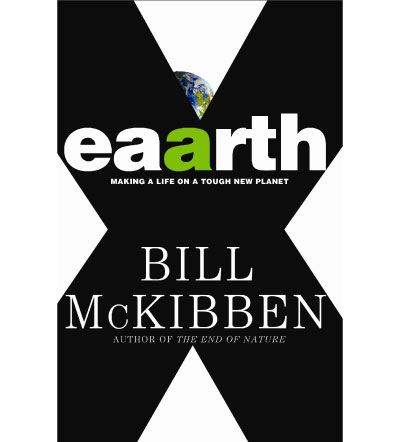
![]() Think of everything you know about global warming. Think, especially, of the sense you might have that there are twenty, thirty, fifty years left before the Earth’s levels of climate change become truly catastrophic. Now, think again. We’re already there, says Bill McKibben in Eaarth (Times Books, $24.00), an eloquent and passionate call to action. In fact, says McKibben, we’ve changed our planet so much that we can no longer think of it as Earth: now it’s Eaarth, a place of melting ice caps, expanding tropics, and increasingly dramatic “weather events”. And we have to learn to live there.
Think of everything you know about global warming. Think, especially, of the sense you might have that there are twenty, thirty, fifty years left before the Earth’s levels of climate change become truly catastrophic. Now, think again. We’re already there, says Bill McKibben in Eaarth (Times Books, $24.00), an eloquent and passionate call to action. In fact, says McKibben, we’ve changed our planet so much that we can no longer think of it as Earth: now it’s Eaarth, a place of melting ice caps, expanding tropics, and increasingly dramatic “weather events”. And we have to learn to live there.
McKibben should know what he’s talking about. A leading journalist and environmental activist, he’s been writing on this subject for more than twenty years. In 1989, his The End of Nature was the first book on global warming for a general audience. In the past two years, his nonprofit 350.org has mobilized millions of people across the world to combat climate change.
In Eaarth, he makes no bones about how serious the situation has become. We’ve already raised the temperature of the planet by one degree Celcius, he writes; as a result, the Arctic ice cap is 1.1 million square miles smaller, and (since warmer air holds more water vapor) global rainfall is increasing by 1.5 percent a decade. But this isn’t just a book full of dry statistics. McKibben is expert at explaining, lucidly and frankly, just what the numbers mean, and what we can do about them. “Forget the grandkids,” he writes. “It turns out this was a problem for our parents.”
(more…)



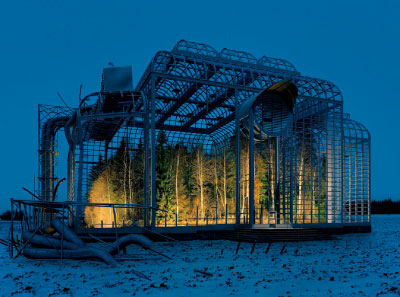
Ilkka Halso, Museum of Nature: Museum I, 2003. All images courtesy of Museum fur Kunst und Gewerbe (Click images to enlarge)
These artists attack the problem at various scales. Some are creating specialized articles of clothing to protect the human body from increasingly damaging atmospheric conditions. Lucy Orta crafted a tent-like, nylon garment that gives protection from the light, heat, cold, and water. Equipped with its own whistle, lantern, and compass, it’s like a highly-evolved all-weather coat. Performance artist Lawrence Mastaf designed a clear vacuum-sealed plastic trap for himself, in which he lies suspended with only slender tubes to breathe through. It’s a spectacle that’s both eery and peaceful. He’s preserved like a biological specimen, and floating dreamily like an embryo.
(more…)


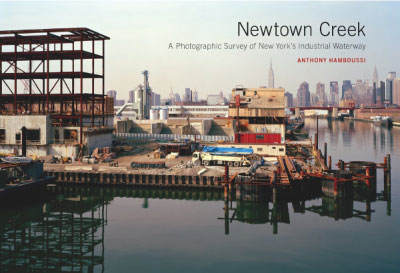
Photography by Anthony Hamboussi. Courtesy of Princeton Architectural Press

Brooklyn-based photographer Anthony Hamboussi traveled the length of the creek from 2001 to 2006 to compile Newtown Creek: A Photographic Survey of New York’s Industrial Waterway. His images poignantly capture the remains of what was once a thriving industrial culture. Waterfront plots are built up with factories, warehouses, silos, smokestacks, and shipping piers, many abandoned and in disrepair. The creek itself is visible only in low, dark stretches, frozen in the winter and fetid in the summer. It looks more like a sewer than a natural body of water. Some factories along the shores remain active, but the only signs of natural life are weeds sprouting up through the paving.
(more…)


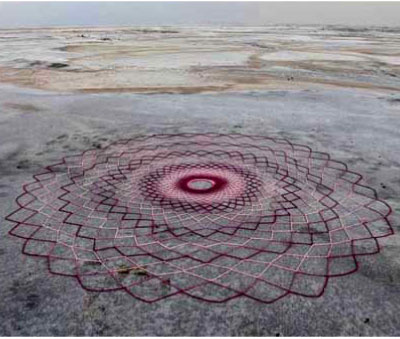
Atefeh Kash and Tarah Goodarzy's crocheted fiber installation in Iran (photography by Sharnaz Zarkesh)
According to Doan, (Re)Fashioning Fiber will include “collaborative environmental fiber art from Iran; handcrafted vegetation jewelry from Bulgaria; sustainable, locally-minded fashion and drawings by Eko-Lab; no-waste textile fashion by Study NY; recycled ‘flotsam fiber’ from the streets of NYC; handmade books spinning tales about a global pilgrimage; crochet tower structures infused with sound”, and much more.
(Re)Fashioning Fiber opens tomorrow, May 20, 6:30-8:30pm at Green Spaces NY, 394 Broadway, 5th Floor. The exhibit will be on view through August 13, 2010.
(more…)


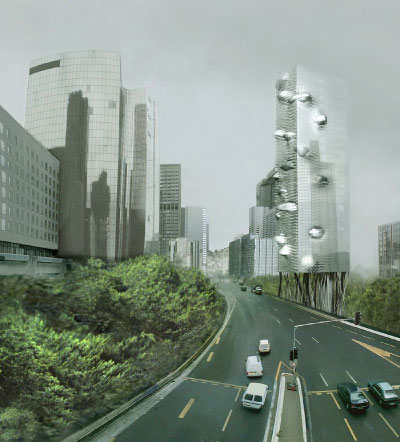
(un)plug, design for an office tower in Paris
Green thinking is changing the way we build. We’re reusing existing structures and materials, designing more efficient building systems, and thinking about long-term sustainability. But these changes are minor in view of the far deeper changes to come, as ecologically-minded designers reexamine their most fundamental assumptions about a door and a roof and a foundation, and reimagine what a building is entirely.
The visionary French architecture office R&Sie(n) is right at the forefront. Its projects, collected in the book Bioreboot: The Architecture of R&Sie(n), offer an architecture that’s deeply enmeshed with natural forces, and entirely liberated from modern conventions about design and construction.
Since the mid-nineteenth century, when steel framing supplanted heavy masonry construction, buildings have been conceived as stable shells that shaped efficient interior environments, as machines for living. R&Sie(n) complicates this paradigm. Its buildings aren’t discrete, unchanging objects but mutable devices embedded within ecologies of weather, time, geology, flora, and fauna.
(more…)

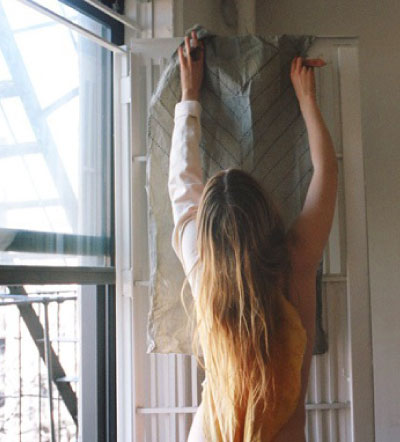
Photography by Lily Ferguson
Sustainable Exchange: Methods and Practices for Collaborative Partnerships will be open for public participation on May 7th-9th from 2-6pm at TODA Design Studio, 250 West Broadway, 6th Floor.

![]()
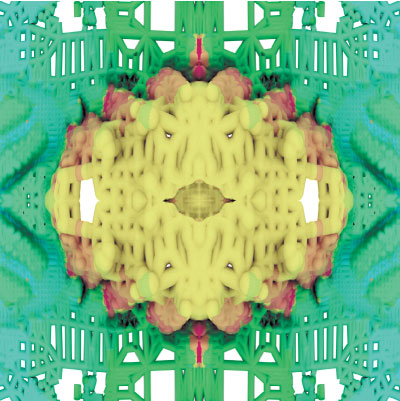
FAB.REcology by Neri Oxman, 2009 winner of The Earth Awards
The Earth Awards is an attempt to bring international public awareness to the necessity of sustainable design. An annual competition since 2007, the Earth Awards “came from a collective of creative thinkers who were designers, architects, scientists, writers, entrepreneurs”, says director Karena Albers. Collectively, the group was “in agreement that not only [are] good design and sustainable design synonymous, but also that … this movement of environmentalism was not moving ahead as quickly as we would have liked, and we believed it was because sustainable thinking wasn’t integrated into popular culture”.
The Earth Awards’ mission is to “find good design and then to connect the innovator with whatever that innovator needs to further his idea or her idea into the marketplace”, says Albers. Past winners have integrated biomimicry with building design, designed solar-powered LED lighting schemes, and created sustainable ways to farm ocean fish.
A particular strength of the Earth Awards lies in its selection committee. The Awards aim to bring in some of the most visible (and visionary) minds in the fields of art, architecture, design, environmentalism, activism and fashion. The eclectic group of judges ranges from Jane Goodall to Diane von Furstenberg to Paola Antonelli, the Senior Curator for Architecture and Design at MoMA.
(more…)


![]()
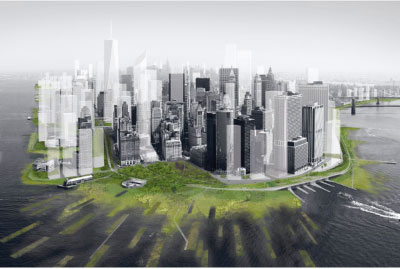
ARO and dlandstudio, section showing green infiltration streets.

We move through New York City largely unconscious of the bodies of water that surround us. Our neighborhoods turn inward, onto streets and parks. Even when we’re on the waterfront our rivers and inlets remain lovely backdrops; we don’t fully understand the forces that move them and the life they support.
In fact the city’s sea level is rising due to global warming, and could be nearly two feet higher fifty years from now. This would endanger much of the city’s existing waterfront, overloading sewers and eroding foundations. The curators of Rising Currents: Projects for New York’s Waterfront, on display now at MoMA through October 11, selected five regions of the waterfront that are particularly vulnerable and asked five local design teams for their solutions.
Their vivid proposals all highlight “soft infrastructure”, that is, broadly-based ecological interventions rather than purely structural ones. So instead of wrapping the shorelines in a concrete super-wall, the teams employ inventive planning, planting, and building to meet the challenge.
Somewhat audaciously, three of the five schemes continue building the city out over the water. ARO and dlandstudio extend the tightly-woven fabric of downtown Manhattan outward, building porous streets from an engineered mesh of concrete and seawater plants.
(more…)

This famous image, which became known as “Earthrise”, is the first photograph of our world ever taken from space. It was captured over Christmas Eve in 1968, and was published about two weeks later in January 1969. It’s hard to imagine, in our era of infinite and immediate information, where we’ve seen and known already virtually everything there is to see and know, that this was the first time in history that humans had ever looked upon their home with any perspective, as a single, whole, and incredibly small world floating in space.
But it was.
And it was only a little over forty years ago.
Volumes can be written about the philosophical, spiritual, and mythological shifts that this new perspective, necessarily, forces upon us as a species. It was well noted that seeing Earth from this vantage point had a profound emotional impact on the astronauts who were there — as I imagine it must have also affected any human being on Earth who was able to absorb the simple, plain reality the image presented us with.
To me, it’s not surprising that Earth Day was founded within a year of the publication of this photograph, and then inaugurated about seven months later on April 22, 1970, marking the beginning of the modern environmental movement.
(more…)


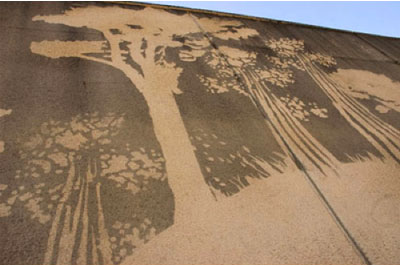
Photography courtesy of Reverse Graffiti Project

Let’s face it. For every movement, there’s a counter-movement — even in the graffiti world. It appears that the ubiquitous spirit of graffiti in urban areas has finally spawned a new generation of taggers, with one major difference, however: these new deviants prefer to wield cleaning materials rather than cans of spray paint.
In past decade, Reverse Graffiti (an art form that removes dirt, dust, and decay rather than adding paint) has experienced something of a mass migration across the world. Crafty examples can be found on everything from filthy car windows to highway tunnels and exit ramps. Huge projects along with small outbursts have exacted equal exposure in places like San Francisco, São Paulo, the UK, Israel, Germany, and Amsterdam. Though the majority of clean graffiti artists cite environmental concerns and/or political issues as their muse, even big-shot companies like Microsoft and Smirnoff have gotten in on the action, sensing a hip new method of advertisement.
The movement, which traces back to British artist Paul “Moose” Curtis, the self-titled “Professor of Dirt”, is currently enticing new disciples in South Africa. Martin Pace, a student living in Durban, modified Moose’s technique in his own neighborhood for a final school project. Using a metal scrubbing brush instead of a high-pressure water hose, Pace etched a fifty-five-foot timeline of Westville’s architecture into a freeway wall. Since then, Pace has recruited a few of his buddies, formed a group called Dutch Ink, and continues to hit the streets, leaving beautiful organic murals behind.
(more…)






 Facebook
Facebook Permalink
Permalink Digg
Digg Reddit
Reddit LinkedIn
LinkedIn StumbleUpon
StumbleUpon Tumblr
Tumblr